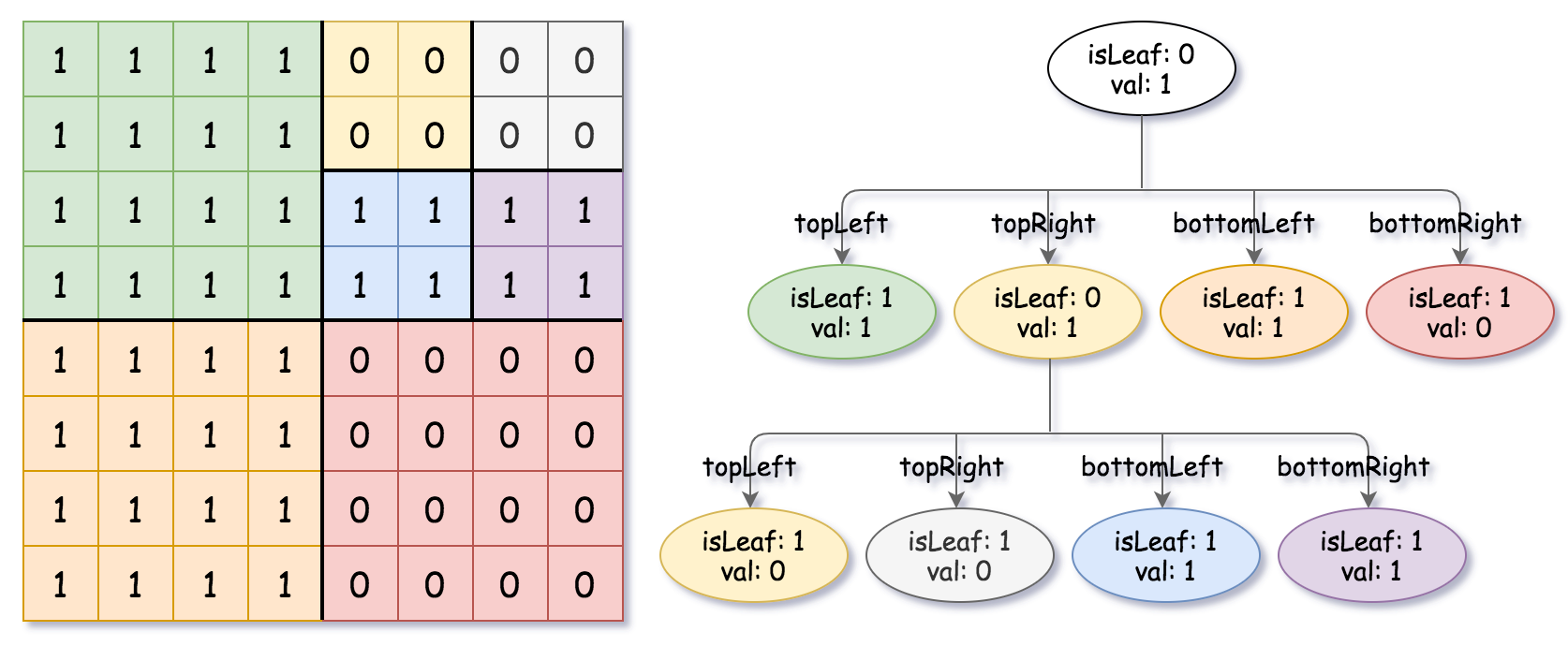上次编辑到这里,代码来自缓存 点击恢复默认模板
/*
// Definition for a QuadTree node.
class Node {
public:
bool val;
bool isLeaf;
Node* topLeft;
Node* topRight;
Node* bottomLeft;
Node* bottomRight;
Node() {
val = false;
isLeaf = false;
topLeft = NULL;
topRight = NULL;
bottomLeft = NULL;
bottomRight = NULL;
}
Node(bool _val, bool _isLeaf) {
val = _val;
isLeaf = _isLeaf;
topLeft = NULL;
topRight = NULL;
bottomLeft = NULL;
bottomRight = NULL;
}
Node(bool _val, bool _isLeaf, Node* _topLeft, Node* _topRight, Node* _bottomLeft, Node* _bottomRight) {
val = _val;
isLeaf = _isLeaf;
topLeft = _topLeft;
topRight = _topRight;
bottomLeft = _bottomLeft;
bottomRight = _bottomRight;
}
};
*/
class Solution {
public:
Node* construct(vector<vector<int>>& grid) {
}
};
golang 解法, 执行用时: 12 ms, 内存消耗: 6.5 MB, 提交时间: 2022-11-25 15:58:50
/**
* Definition for a QuadTree node.
* type Node struct {
* Val bool
* IsLeaf bool
* TopLeft *Node
* TopRight *Node
* BottomLeft *Node
* BottomRight *Node
* }
*/
func construct(grid [][]int) *Node {
n := len(grid)
pre := make([][]int, n+1)
pre[0] = make([]int, n+1)
for i, row := range grid {
pre[i+1] = make([]int, n+1)
for j, v := range row {
pre[i+1][j+1] = pre[i+1][j] + pre[i][j+1] - pre[i][j] + v
}
}
var dfs func(r0, c0, r1, c1 int) *Node
dfs = func(r0, c0, r1, c1 int) *Node {
total := pre[r1][c1] - pre[r1][c0] - pre[r0][c1] + pre[r0][c0]
if total == 0 {
return &Node{Val: false, IsLeaf: true}
}
if total == (r1-r0)*(c1-c0) {
return &Node{Val: true, IsLeaf: true}
}
rMid, cMid := (r0+r1)/2, (c0+c1)/2
return &Node{
true,
false,
dfs(r0, c0, rMid, cMid),
dfs(r0, cMid, rMid, c1),
dfs(rMid, c0, r1, cMid),
dfs(rMid, cMid, r1, c1),
}
}
return dfs(0, 0, n, n)
}
python3 解法, 执行用时: 252 ms, 内存消耗: 16.3 MB, 提交时间: 2022-11-25 15:58:24
"""
# Definition for a QuadTree node.
class Node:
def __init__(self, val, isLeaf, topLeft, topRight, bottomLeft, bottomRight):
self.val = val
self.isLeaf = isLeaf
self.topLeft = topLeft
self.topRight = topRight
self.bottomLeft = bottomLeft
self.bottomRight = bottomRight
"""
class Solution:
def construct(self, grid: List[List[int]]) -> 'Node':
n = len(grid)
pre = [[0] * (n + 1) for _ in range(n + 1)]
for i in range(1, n + 1):
for j in range(1, n + 1):
pre[i][j] = pre[i - 1][j] + pre[i][j - 1] - pre[i - 1][j - 1] + grid[i - 1][j - 1]
def getSum(r0: int, c0: int, r1: int, c1: int) -> int:
return pre[r1][c1] - pre[r1][c0] - pre[r0][c1] + pre[r0][c0]
def dfs(r0: int, c0: int, r1: int, c1: int) -> 'Node':
total = getSum(r0, c0, r1, c1)
if total == 0:
return Node(False, True)
if total == (r1 - r0) * (c1 - c0):
return Node(True, True)
return Node(
True,
False,
dfs(r0, c0, (r0 + r1) // 2, (c0 + c1) // 2),
dfs(r0, (c0 + c1) // 2, (r0 + r1) // 2, c1),
dfs((r0 + r1) // 2, c0, r1, (c0 + c1) // 2),
dfs((r0 + r1) // 2, (c0 + c1) // 2, r1, c1),
)
return dfs(0, 0, n, n)
golang 解法, 执行用时: 8 ms, 内存消耗: 6.5 MB, 提交时间: 2022-11-25 15:57:57
/**
* Definition for a QuadTree node.
* type Node struct {
* Val bool
* IsLeaf bool
* TopLeft *Node
* TopRight *Node
* BottomLeft *Node
* BottomRight *Node
* }
*/
func construct(grid [][]int) *Node {
var dfs func([][]int, int, int) *Node
dfs = func(rows [][]int, c0, c1 int) *Node {
for _, row := range rows {
for _, v := range row[c0:c1] {
if v != rows[0][c0] { // 不是叶节点
rMid, cMid := len(rows)/2, (c0+c1)/2
return &Node{
true,
false,
dfs(rows[:rMid], c0, cMid),
dfs(rows[:rMid], cMid, c1),
dfs(rows[rMid:], c0, cMid),
dfs(rows[rMid:], cMid, c1),
}
}
}
}
// 是叶节点
return &Node{Val: rows[0][c0] == 1, IsLeaf: true}
}
return dfs(grid, 0, len(grid))
}
python3 解法, 执行用时: 216 ms, 内存消耗: 15.9 MB, 提交时间: 2022-11-25 15:57:34
"""
# Definition for a QuadTree node.
class Node:
def __init__(self, val, isLeaf, topLeft, topRight, bottomLeft, bottomRight):
self.val = val
self.isLeaf = isLeaf
self.topLeft = topLeft
self.topRight = topRight
self.bottomLeft = bottomLeft
self.bottomRight = bottomRight
"""
class Solution:
def construct(self, grid: List[List[int]]) -> 'Node':
def dfs(r0: int, c0: int, r1: int, c1: int) -> 'Node':
if all(grid[i][j] == grid[r0][c0] for i in range(r0, r1) for j in range(c0, c1)):
return Node(grid[r0][c0] == 1, True)
return Node(
True,
False,
dfs(r0, c0, (r0 + r1) // 2, (c0 + c1) // 2),
dfs(r0, (c0 + c1) // 2, (r0 + r1) // 2, c1),
dfs((r0 + r1) // 2, c0, r1, (c0 + c1) // 2),
dfs((r0 + r1) // 2, (c0 + c1) // 2, r1, c1),
)
return dfs(0, 0, len(grid), len(grid))




